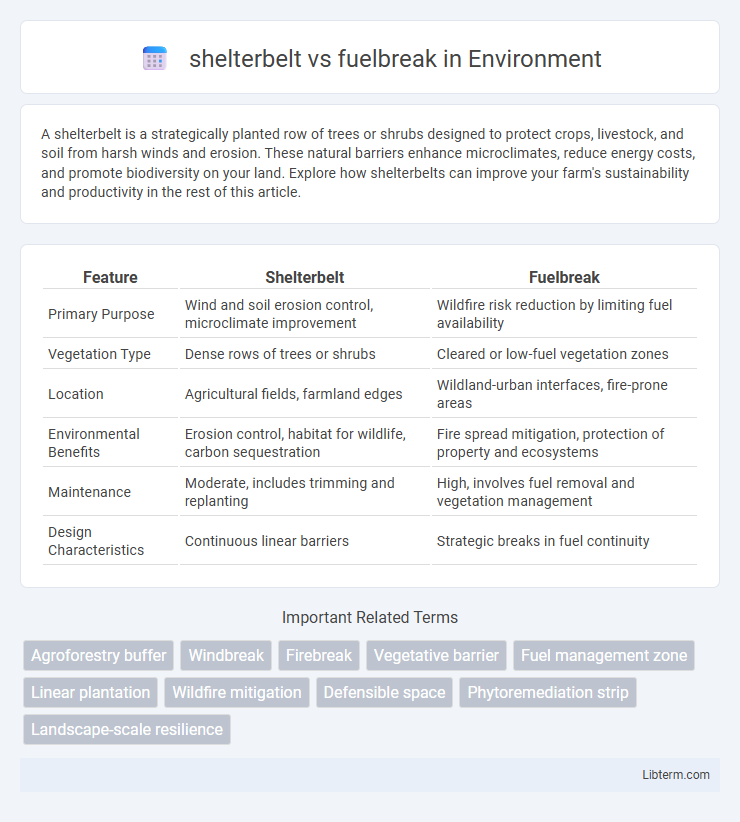A shelterbelt is a strategically planted row of trees or shrubs designed to protect crops, livestock, and soil from harsh winds and erosion. These natural barriers enhance microclimates, reduce energy costs, and promote biodiversity on your land. Explore how shelterbelts can improve your farm's sustainability and productivity in the rest of this article.
Table of Comparison
| Feature | Shelterbelt | Fuelbreak |
|---|---|---|
| Primary Purpose | Wind and soil erosion control, microclimate improvement | Wildfire risk reduction by limiting fuel availability |
| Vegetation Type | Dense rows of trees or shrubs | Cleared or low-fuel vegetation zones |
| Location | Agricultural fields, farmland edges | Wildland-urban interfaces, fire-prone areas |
| Environmental Benefits | Erosion control, habitat for wildlife, carbon sequestration | Fire spread mitigation, protection of property and ecosystems |
| Maintenance | Moderate, includes trimming and replanting | High, involves fuel removal and vegetation management |
| Design Characteristics | Continuous linear barriers | Strategic breaks in fuel continuity |
Understanding Shelterbelts and Fuelbreaks
Shelterbelts are rows of trees or shrubs planted to protect crops, soil, and livestock from wind erosion, enhancing microclimates and conserving moisture. Fuelbreaks function as strategically cleared or managed zones designed to reduce wildfire intensity by interrupting fuel continuity such as dense vegetation and combustible materials. Both play distinct roles in land management, with shelterbelts primarily mitigating wind effects while fuelbreaks focus on wildfire risk reduction.
Core Functions: Shelterbelt vs Fuelbreak
Shelterbelts serve primarily to reduce wind speed, control soil erosion, and protect crops by creating a microclimate, while fuelbreaks function to interrupt fire spread by removing or reducing flammable vegetation. Shelterbelts consist of closely planted trees or shrubs arranged to act as physical barriers against wind and dust, enhancing agricultural productivity. Fuelbreaks incorporate strategically cleared or thinned vegetation zones designed to slow wildfire progression and facilitate firefighting efforts.
Design Principles: Structure and Composition
Shelterbelts are designed as dense, multi-row plantings of trees and shrubs to reduce wind speed and protect soil, optimizing structure through varied species and staggered spacing to maximize microclimate benefits. Fuelbreaks prioritize fire control by creating strategically spaced vegetation zones with lower fuel loads and fewer ladder fuels, emphasizing open structure and reduced canopy continuity to slow fire spread. The composition of shelterbelts encourages biodiversity and soil stabilization, while fuelbreaks focus on fire-resistant species and mechanical thinning to interrupt fire pathways effectively.
Ecological Impact and Biodiversity
Shelterbelts enhance ecological impact by promoting biodiversity through habitat creation and soil stabilization, supporting various flora and fauna. Fuelbreaks primarily focus on reducing wildfire risk by removing combustible vegetation, which may limit habitat diversity but help preserve larger ecosystems from fire damage. Both strategies play distinct roles in landscape management with shelterbelts fostering biodiversity and fuelbreaks mitigating fire impact for ecological balance.
Role in Fire Prevention and Control
Shelterbelts act as wind barriers that reduce wind speed and help prevent the spread of wildfires by limiting the availability of dry fuels near homes and agricultural areas. Fuelbreaks are strategically cleared or thinned zones designed to slow or stop the progress of active fires by removing combustible vegetation and creating defensible spaces for firefighting efforts. Both shelterbelts and fuelbreaks are essential components in fire management, with shelterbelts primarily aiding in fire prevention and fuelbreaks focusing on fire control during active wildfire events.
Climate and Environmental Benefits
Shelterbelts, composed of dense rows of trees or shrubs, reduce wind speed, which decreases soil erosion and enhances microclimate conditions, promoting biodiversity and carbon sequestration. Fuelbreaks are strategically cleared strips designed to slow wildfires, reducing fire severity and protecting ecosystems, while also mitigating greenhouse gas emissions from uncontrolled burns. Both contribute significantly to climate resilience by stabilizing landscapes and preserving air quality.
Implementation Challenges
Implementing shelterbelts faces challenges such as selecting appropriate tree species for local soil and climate conditions, managing water usage, and ensuring long-term maintenance to sustain wind protection and soil erosion control. Fuelbreaks require careful design to effectively reduce wildfire fuel loads while minimizing ecological disruption, often demanding extensive vegetation clearing and coordination with fire management agencies. Both strategies contend with land availability constraints, potential impacts on biodiversity, and the need for ongoing monitoring to adapt to environmental changes.
Maintenance and Sustainability
Shelterbelts require consistent maintenance such as pruning, pest control, and replanting to ensure long-term growth and effectiveness in wind reduction and soil conservation. Fuelbreaks demand regular clearing of flammable vegetation and controlled burns to maintain their role in wildfire prevention and minimize fuel loads. Sustainable management of shelterbelts supports biodiversity and carbon sequestration, while fuelbreaks focus on reducing wildfire risk through periodic vegetation management and soil protection practices.
Cost-Effectiveness Comparison
Shelterbelts are cost-effective for long-term benefits by reducing wind erosion and shielding crops, often requiring lower maintenance and providing multi-functional ecosystem services. Fuelbreaks typically demand higher initial investment and ongoing upkeep to maintain fire-resistant vegetation and clear buffer zones, aiming to reduce wildfire spread. Economically, shelterbelts offer greater value in agricultural productivity enhancement, while fuelbreaks prioritize wildfire mitigation, making their cost-effectiveness dependent on regional risk factors and land use priorities.
Selecting the Right Solution for Your Land
Shelterbelts are rows of trees or shrubs planted to protect soil and crops from wind erosion, improving microclimate and increasing biodiversity. Fuelbreaks are cleared or thinned zones designed to slow or stop wildfire spread by reducing combustible vegetation. Selecting the right solution depends on land goals: use shelterbelts for agricultural protection and habitat enhancement, while fuelbreaks are crucial for wildfire risk reduction in fire-prone areas.
shelterbelt Infographic

 libterm.com
libterm.com